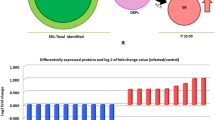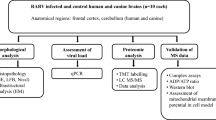Abstract
In order to extend the knowledge of rabies pathogenesis, a two-dimensional electrophoresis/mass spectrometry based postmortem comparative proteomics analysis was carried out on human brain samples. Alteration in expression profile of several proteins was detected. Proteins related to cytoskeleton, metabolism, proteasome and immune regulatory systems showed the most changes in expression levels. Among these groups, the cytoskeleton related proteins (dynein light chain, β-centractin, tubulin alpha-1C chain and destrin) and metabolism associated proteins (fatty acid-binding protein, macrophage migration inhibitory factor, glutamine synthetase and alpha enolase) were the main altered proteins. These alterations may be considered as an evidence of disturbances in neuronal key processes including axonal transport, synaptic activity, signaling and metabolic pathways in rabies virus infected human brain.



Similar content being viewed by others
References
Jackson AC (1991) Biological basis of rabies virus neurovirulence in mice: comparative pathogenesis study using the immunoperoxidase technique. J Virol 65(1):537–540
Wunner WH, Briggs DJ (2010) Rabies in the 21 century. PLoS Negl Trop Dis 4(3):e591
Leung AK, Davies HD, Hon KL (2007) Rabies: epidemiology, pathogenesis, and prophylaxis. Adv Ther 24(6):1340–1347
Durai R, Venkatraman R (2006) Human rabies and its prevention. Br J Hosp Med (Lond) 67(11):588–593
Dhingra V, Li X, Liu Y, Fu ZF (2007) Proteomic profiling reveals that rabies virus infection results in differential expression of host proteins involved in ion homeostasis and synaptic physiology in the central nervous system. J Neurovirol 13(2):107–117
Zandi F, Eslami N, Soheili M, Fayaz A, Gholami A, Vaziri B (2009) Proteomics analysis of BHK-21 cells infected with a fixed strain of rabies virus. Proteomics 9(9):2399–2407
Wang X, Zhang S, Sun C, Yuan ZG, Wu X, Wang D, Ding Z, Hu R (2011) Proteomic profiles of mouse neuro N2a cells infected with variant virulence of rabies viruses. J Microbiol Biotechnol 21(4):366–373
Thanomsridetchai N, Singhto N, Tepsumethanon V, Shuangshoti S, Wacharapluesadee S, Sinchaikul S, Chen ST, Hemachudha T, Thongboonkerd V (2011) Comprehensive proteome analysis of hippocampus, brainstem, and spinal cord from paralytic and furious dogs naturally infected with rabies. J Proteome Res 10(11):4911–4924
Zandi F, Eslami N, Torkashvand F, Fayaz A, Khalaj V, Vaziri B (2013) Expression changes of cytoskeletal associated proteins in proteomic profiling of neuroblastoma cells infected with different strains of rabies virus. J Med Virol 85(2):336–347
Martins-de-Souza D, Menezes de Oliveira B, dos Santos Farias A, Horiuchi RS, Crepaldi Domingues C, de Paula E, Marangoni S, Gattaz WF, Dias-Neto E, Camillo Novello J (2007) The use of ASB-14 in combination with CHAPS is the best for solubilization of human brain proteins for two-dimensional gel electrophoresis. Brief Funct Genomics Proteomics 6(1):70–75
Bradford MM (1976) A rapid and sensitive method for the quantitation of microgram quantities of protein utilizing the principle of protein-dye binding. Anal Biochem 72:248–254
Candiano G, Bruschi M, Musante L, Santucci L, Ghiggeri GM, Carnemolla B, Orecchia P, Zardi L, Righetti PG (2004) Blue silver: a very sensitive colloidal Coomassie G-250 staining for proteome analysis. Electrophoresis 25(9):1327–1333
Maxwell KL, Frappier L (2007) Viral proteomics. Microbiol Mol Biol Rev 71(2):398–411
Levy JR, Holzbaur EL (2006) Cytoplasmic dynein/dynactin function and dysfunction in motor neurons. Int J Dev Neurosci 24(2–3):103–111
Gulesserian T, Kim SH, Fountoulakis M, Lubec G (2002) Aberrant expression of centractin and capping proteins, integral constituents of the dynactin complex, in fetal down syndrome brain. Biochem Biophys Res Commun 291(1):62–67
Vallee RB, Williams JC, Varma D, Barnhart LE (2004) Dynein: an ancient motor protein involved in multiple modes of transport. J Neurobiol 58(2):189–200
Weng YQ, Qiu SJ, Liu YK, Fan J, Gao Q, Tang ZY (2008) Down-regulation of beta-centractin might be involved in dendritic cells dysfunction and subsequent hepatocellular carcinoma immune escape: a proteomic study. J Cancer Res Clin Oncol 134(2):179–186
Raux H, Flamand A, Blondel D (2000) Interaction of the rabies virus P protein with the LC8 dynein light chain. J Virol 74(21):10212–10216
Sarmiere PD, Bamburg JR (2004) Regulation of the neuronal actin cytoskeleton by ADF/cofilin. J Neurobiol 58(1):103–117
Ceccaldi PE, Valtorta F, Braud S, Hellio R, Tsiang H (1997) Alteration of the actin-based cytoskeleton by rabies virus. J General Virol 78(Pt 11):2831–2835
Vartiainen MK, Mustonen T, Mattila PK, Ojala PJ, Thesleff I, Partanen J, Lappalainen P (2002) The three mouse actin-depolymerizing factor/cofilins evolved to fulfill cell-type-specific requirements for actin dynamics. Mol Biol Cell 13(1):183–194
Yeoh S, Pope B, Mannherz HG, Weeds A (2002) Determining the differences in actin binding by human ADF and cofilin. J Mol Biol 315(4):911–925
Verdoni AM, Aoyama N, Ikeda A, Ikeda S (2008) Effect of destrin mutations on the gene expression profile in vivo. Physiol Genomics 34(1):9–21
Kiuchi T, Nagai T, Ohashi K, Mizuno K (2011) Measurements of spatiotemporal changes in G-actin concentration reveal its effect on stimulus-induced actin assembly and lamellipodium extension. J Cell Biol 193(2):365–380
Wang WH, Abeydeera LR, Prather RS, Day BN (2000) Polymerization of nonfilamentous actin into microfilaments is an important process for porcine oocyte maturation and early embryo development. Biol Reprod 62(5):1177–1183
Owada Y, Yoshimoto T, Kondo H (1996) Spatio-temporally differential expression of genes for three members of fatty acid binding proteins in developing and mature rat brains. J Chem Neuroanat 12(2):113–122
Bacher M, Meinhardt A, Lan HY, Dhabhar FS, Mu W, Metz CN, Chesney JA, Gemsa D, Donnelly T, Atkins RC, Bucala R (1998) MIF expression in the rat brain: implications for neuronal function. Mol Med 4(4):217–230
Murphy EJ, Owada Y, Kitanaka N, Kondo H, Glatz JF (2005) Brain arachidonic acid incorporation is decreased in heart fatty acid binding protein gene-ablated mice. Biochemistry 44(16):6350–6360
Shioda N, Yamamoto Y, Watanabe M, Binas B, Owada Y, Fukunaga K (2010) Heart-type fatty acid binding protein regulates dopamine D2 receptor function in mouse brain. J Neurosci 30(8):3146–3155
Mitchell RA, Liao H, Chesney J, Fingerle-Rowson G, Baugh J, David J, Bucala R (2002) Macrophage migration inhibitory factor (MIF) sustains macrophage proinflammatory function by inhibiting p53: regulatory role in the innate immune response. Proc Natl Acad Sci USA 99(1):345–350
Bozza M, Satoskar AR, Lin G, Lu B, Humbles AA, Gerard C, David JR (1999) Targeted disruption of migration inhibitory factor gene reveals its critical role in sepsis. J Exp Med 189(2):341–346
Bernhagen J, Mitchell RA, Calandra T, Voelter W, Cerami A, Bucala R (1994) Purification, bioactivity, and secondary structure analysis of mouse and human macrophage migration inhibitory factor (MIF). Biochemistry 33(47):14144–14155
Poon HF, Vaishnav RA, Getchell TV, Getchell ML, Butterfield DA (2006) Quantitative proteomics analysis of differential protein expression and oxidative modification of specific proteins in the brains of old mice. Neurobiol Aging 27(7):1010–1019
Robinson SR (2001) Changes in the cellular distribution of glutamine synthetase in Alzheimer’s disease. J Neurosci Res 66(5):972–980
Darman J, Backovic S, Dike S, Maragakis NJ, Krishnan C, Rothstein JD, Irani DN, Kerr DA (2004) Viral-induced spinal motor neuron death is non-cell-autonomous and involves glutamate excitotoxicity. J Neurosci 24(34):7566–7575
Weli SC, Scott CA, Ward CA, Jackson AC (2006) Rabies virus infection of primary neuronal cultures and adult mice: failure to demonstrate evidence of excitotoxicity. J Virol 80(20):10270–10273
de Vrij FM, Fischer DF, van Leeuwen FW, Hol EM (2004) Protein quality control in Alzheimer’s disease by the ubiquitin proteasome system. Prog Neurobiol 74(5):249–270
Pak DT, Sheng M (2003) Targeted protein degradation and synapse remodeling by an inducible protein kinase. Science 302(5649):1368–1373
McNaught KS, Belizaire R, Isacson O, Jenner P, Olanow CW (2003) Altered proteasomal function in sporadic Parkinson’s disease. Exp Neurol 179(1):38–46
McNaught KS, Jackson T, JnoBaptiste R, Kapustin A, Olanow CW (2006) Proteasomal dysfunction in sporadic Parkinson’s disease. Neurology 66(10 Suppl 4):S37–S49
McNaught KS, Olanow CW (2006) Protein aggregation in the pathogenesis of familial and sporadic Parkinson’s disease. Neurobiol Aging 27(4):530–545
Sherman MY, Goldberg AL (2001) Cellular defenses against unfolded proteins: a cell biologist thinks about neurodegenerative diseases. Neuron 29(1):15–32
Cassarino DS, Bennett JP Jr (1999) An evaluation of the role of mitochondria in neurodegenerative diseases: mitochondrial mutations and oxidative pathology, protective nuclear responses, and cell death in neurodegeneration. Brain Res 29(1):1–25
Shamoto-Nagai M, Maruyama W, Kato Y, Isobe K, Tanaka M, Naoi M, Osawa T (2003) An inhibitor of mitochondrial complex I, rotenone, inactivates proteasome by oxidative modification and induces aggregation of oxidized proteins in SH-SY5Y cells. J Neurosci Res 74(4):589–597
Altar CA, Jurata LW, Charles V, Lemire A, Liu P, Bukhman Y, Young TA, Bullard J, Yokoe H, Webster MJ, Knable MB, Brockman JA (2005) Deficient hippocampal neuron expression of proteasome, ubiquitin, and mitochondrial genes in multiple schizophrenia cohorts. Biol Psychiatry 58(2):85–96
Tholey G, Ledig M, Mandel P (1982) Modifications in energy metabolism during the development of chick glial cells and neurons in culture. Neurochem Res 7(1):27–36
Acknowledgments
This study was supported by grant No. 438 from Pasteur Institute of Iran. Authors acknowledge gratefully Dr. Adam Dowle (Proteomics Technology Facility, Department of Biology, University of York, England) for his critical review on matrix-assisted laser desorption/ionization-time of flight/time of flight mass spectrometry analysis. We also thank, Fatemeh Torkashvand, Elmira Haghighatjoo, Atefeh Mirzakhani and Ahmad Adeli for technical and supportive help.
Author information
Authors and Affiliations
Corresponding author
Additional information
Firouzeh Farahtaj and Fatemeh Zandi have equally contributed to this work.
Electronic supplementary material
Below is the link to the electronic supplementary material.
Rights and permissions
About this article
Cite this article
Farahtaj, F., Zandi, F., Khalaj, V. et al. Proteomics analysis of human brain tissue infected by street rabies virus. Mol Biol Rep 40, 6443–6450 (2013). https://doi.org/10.1007/s11033-013-2759-0
Received:
Accepted:
Published:
Issue Date:
DOI: https://doi.org/10.1007/s11033-013-2759-0




